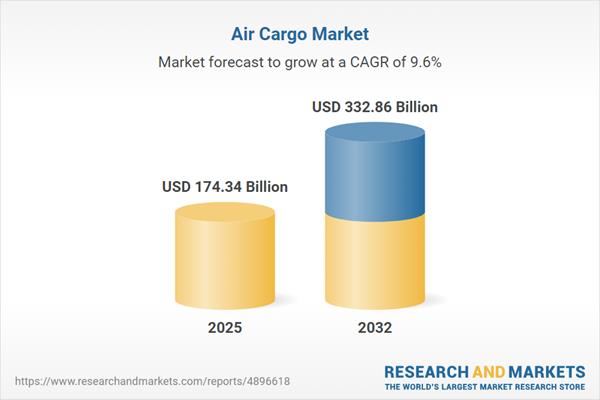Speak directly to the analyst to clarify any post sales queries you may have.
The global air cargo market is experiencing significant transitions as supply chains grow more complex and digital and sustainability imperatives accelerate transformation. Decision-makers now face evolving operational and strategic challenges that demand advanced insights for informed, future-ready logistics investments.
Market Snapshot: Air Cargo Market Size and Growth Outlook
The Air Cargo Market grew from USD 159.77 billion in 2024 to USD 174.34 billion in 2025. It is expected to continue growing at a CAGR of 9.60%, reaching USD 332.86 billion by 2032. This sustained growth reflects heightened demand for rapid, reliable, and resilient logistics networks across global trade corridors. Strategic investments in digital technologies and sustainability initiatives position the sector for continued evolution and diversified opportunity.
Scope & Segmentation: Comprehensive Analysis of the Air Cargo Landscape
This report provides in-depth coverage, analyzing critical market drivers, segmentation, and operational technologies shaping the air cargo sector. The study examines:
- Cargo Type: General cargo; special cargo, including fragile, hazardous, and perishable goods.
- Service Type: Express delivery; standard delivery.
- Aircraft Type: Narrow-body aircraft; wide-body aircraft.
- Application: Domestic; international.
- End-User: Food & Beverages; Healthcare & Pharmaceuticals; Military & Defense; Retail & Consumer Goods.
- Region: Americas (United States, Canada, Mexico, Brazil, Argentina, Chile, Colombia, Peru), Europe, Middle East & Africa (United Kingdom, Germany, France, Russia, Italy, Spain, Netherlands, Sweden, Poland, Switzerland, United Arab Emirates, Saudi Arabia, Qatar, Turkey, Israel, South Africa, Nigeria, Egypt, Kenya), Asia-Pacific (China, India, Japan, Australia, South Korea, Indonesia, Thailand, Malaysia, Singapore, Taiwan).
- Key Companies: AIA Cargo, Air Cargo Carriers, LLC, ATA Freight Line Ltd., Augustin Quehenberger Group GmbH by Geis Group, SEAWAY Group, CMA CGM S.A., Cargolux Airlines International S.A., Cathay Pacific Airways Limited, China Airlines Cargo, Deutsche Post AG, DSV A/S, Allcargo Logistics Limited, Emirates SkyCargo by Emirates Group, Expeditors International of Washington, Inc., Express Air Freight Unlimited, Inc., FedEx Corporation, Hellmann Worldwide Logistics SE & Co. KG.
- Core Technologies: Digital shipment tracking, real-time monitoring, IoT-enabled sensors, blockchain documentation, warehouse automation, robotics, and sustainable aviation fuels.
Key Takeaways for Senior Decision-Makers
- Digitalization is redefining air cargo by enabling real-time shipment monitoring, proactive route decisions, and streamlined documentation, resulting in greater operational transparency and speed.
- Strategic alliances between carriers, integrators, and technology providers create seamless end-to-end offerings and reinforce competitive differentiation in a crowded marketplace.
- Sustainability is now central to operational strategy; investments in alternative fuels, electrified handling equipment, and carbon-reduction programs build both market trust and regulatory compliance.
- Service differentiation—through express versus standard logistics—and careful segmentation allow targeted value delivery for diverse commercial, perishable, and specialized cargo needs.
- Emerging opportunities exist in intra-regional trade, especially as industrial and consumer ecosystems develop across Asia-Pacific, the Americas, and EMEA regions.
- Adjustable network planning and close industry collaboration are essential for mitigating volatility driven by external regulatory and policy shifts.
Tariff Impact: Responding to United States Policy Changes
New United States tariffs announced for 2025 are set to alter established trade lanes and freight economics. These measures prompt shippers to reconsider sourcing strategies and lead to increased operational complexity for carriers, including adjustments to capacity allocation and network routes. Collaborative data sharing and joint planning will be key strategies to lessen the impact of changing tariff environments and to maintain reliable transit times across global corridors.
Methodology & Data Sources: Rigorous, Multi-Dimensional Research
The report’s findings are grounded in a robust methodology, integrating primary research—executive interviews and surveys—with thorough secondary data analysis from leading journals, regulatory sources, and industry panels. Data cross-validation and expert peer reviews reinforce accuracy and actionable relevance for senior stakeholders.
Why This Report Matters
- Offers comprehensive market intelligence to inform high-stakes logistics, procurement, and supply chain decisions within evolving regulatory and economic environments.
- Enables benchmarking of corporate strategies and technology adoption against leading operators in key global markets, enhancing competitive positioning.
- Delivers actionable recommendations for risk mitigation and growth by highlighting major trends, partnership models, and sustainability pathways.
Conclusion
This report equips senior leaders with the strategic clarity needed to navigate disruption and to optimize air cargo operations in an environment shaped by technology, regulation, and stakeholder expectations. By leveraging these insights, organizations can position themselves for growth, resilience, and meaningful differentiation in global air logistics.
Additional Product Information:
- Purchase of this report includes 1 year online access with quarterly updates.
- This report can be updated on request. Please contact our Customer Experience team using the Ask a Question widget on our website.
Table of Contents
3. Executive Summary
4. Market Overview
7. Cumulative Impact of Artificial Intelligence 2025
Companies Mentioned
The companies profiled in this Air Cargo market report include:- AIA Cargo
- Air Cargo Carriers, LLC
- ATA Freight Line Ltd.
- Augustin Quehenberger Group GmbH by Geis Group
- SEAWAY Group
- CMA CGM S.A.
- Cargolux Airlines International S.A.
- Cathay Pacific Airways Limited
- China Airlines Cargo
- Deutsche Post AG
- DSV A/S
- Allcargo Logistics Limited
- Emirates SkyCargo by Emirates Group
- Expeditors International of Washington, Inc.
- Express Air Freight Unlimited, Inc.
- FedEx Corporation
- Hellmann Worldwide Logistics SE & Co. KG
Table Information
| Report Attribute | Details |
|---|---|
| No. of Pages | 189 |
| Published | November 2025 |
| Forecast Period | 2025 - 2032 |
| Estimated Market Value ( USD | $ 174.34 Billion |
| Forecasted Market Value ( USD | $ 332.86 Billion |
| Compound Annual Growth Rate | 9.6% |
| Regions Covered | Global |
| No. of Companies Mentioned | 18 |









